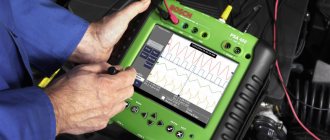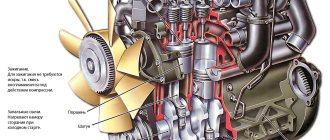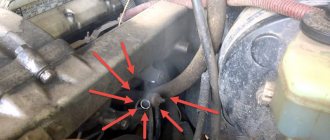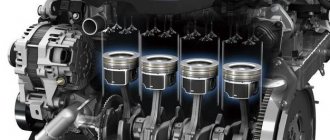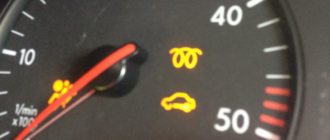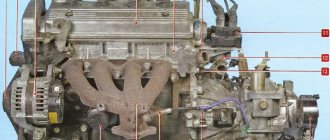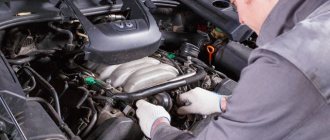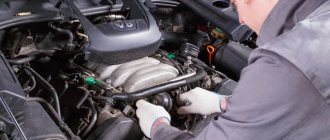In some European countries, there is a fine for prolonged warming up, no matter how cold it is outside, so most foreign manufacturers do not recommend warming up their cars. The main reason for this is environmental pollution.
Below we will try to figure out whether it is necessary to warm up a diesel engine with a turbine, we will indicate all the advantages and disadvantages of warming up, as well as the nuances of the engine’s functioning at different times of the year.
Warming up a diesel engine in winter
Even today, the question of whether to heat or not is relevant even today. Motorists are mainly divided into 2 camps, some say it is necessary, while others say the opposite. Car manufacturers write in their operating instructions that the engine must be warmed up at idle speed. But how and how much to heat diesel in winter?
There are 3 opinions:
- Warm up the diesel engine at idle speed until the power unit warms up.
- Warm up for about 3-5 minutes while you clear the car of snow.
- Get into the car, start it and drive away immediately.
Why are drivers afraid to drive with a cold engine?
Many people have little understanding of what exactly happens under load in a cold engine, but intuitively and on the advice of other enthusiasts, they think that this is very bad for engine mechanics. Most often, an analogy arises with an athlete who starts training without warming up.
If the car owner begins to become more closely acquainted with the equipment, then his fears become stronger. There are actually enough reasons:
- cold thick oil in the crankcase does not cope with its functions, is poorly pumped, and too high pressure threatens to destroy the oil pump drive and rupture the filter housing;
- uneven heating of the cylinder and piston completely eliminates the thermal gap, after which scuffing of parts begins;
- the piston itself heats up from above, remaining relatively cold from below, experiences deforming loads, which causes the ring bridges to break off;
- the mating of the head with the block is distorted, which is fraught with breakdown of the gasket and loosening of the fastening bolts;
- the oil begins to intensively form deposits on the walls of cold parts.
In addition to these effects that threaten breakdowns, there are others that are less dangerous, but quite unpleasant. Working under load with enriching the mixture causes the formation of fuel soot and carbon deposits, the mode of the spark plugs and neutralizer is disrupted, even the control unit may not understand what is happening and, having highlighted an error, go into emergency mode.
You need to know this: Why turn on the air conditioning in your car in winter?
All this is easy to understand when reading popular articles, after which the desire to drive without fully warming up disappears. But in reality nothing special happens.
Why is it worth warming up your diesel engine in winter?
Engine oil
Motor oil forms an oil film, providing the best friction, protecting internal components. Working without oil has a detrimental effect on the engine. And at 20 degrees below zero, motor oil, even with a viscosity of 10w-40, acquires a thick consistency. Even though there are special winter motor oils, they still thicken at low ambient temperatures.
Therefore, it is very important to select the right and high-quality motor oil for the winter. Oil is divided into summer and winter. Summer motor oil will simply thicken , it will be impossible to warm up or start the engine with such oil, and it can also lead to filter clogging.
- Too viscous oil makes it difficult to turn;
- Large gaps form in the mating parts; they are reduced only when warmed up;
- It is quite difficult for the oil pump to pump oil into the system.
During idle time, oil flows from the cylinder walls into the manifold, forming an oil film. And if the oil thickens, this film will not be enough, and the components will be left without lubrication, since too viscous oil will not be able to provide the necessary lubrication.
After running the engine at idle, the oil will warm up, after which the liquid will acquire the necessary viscosity and provide lubrication.
And this is the first argument in favor of heating diesel in winter.
Engine
The engine needs to warm up in order to prevent increased and rapid wear of internal parts. Parts at negative temperatures tend to decrease in size, which leads to an increase in gaps. A diesel engine operates with a higher compression ratio compared to a gasoline engine. As a result, the pistons work under load and wear increases significantly. After heating, the metal returns to its previous shape, as a result of which the operation of the motor becomes more efficient.
It is worth noting that when the engine is cold, cylinders and pistons experience very high loads and wear out quickly . And if you immediately start moving, the load will increase even more significantly. It's worth thinking about, do you need this?
Fuel
Warming up the diesel engine before driving in cold weather is also necessary to save diesel fuel. A cold, unheated engine “eats” much more fuel than a warmed one. All this is due to the fact that the formation of air-fuel mixture is difficult.
While driving, on average the engine warms up for about 9-10 minutes . And if you drive without warming up the engine during this period, the consumption will be much higher than the average when warmed up. Therefore, it is better to spend 5-8 minutes while the engine is warming up to clear snow and ice. After all, this is necessary to ensure traffic safety. Yes, and you'll save fuel.
In addition, at low negative temperatures there is a risk of diesel fuel freezing in the fuel system. The fact is that this type of fuel tends to lose fluidity at low temperatures. And the power unit may stall after a couple of kilometers without warming up. Therefore, it is better to warm it up first, making sure that there is normal fluidity and a stable fuel supply.
Another compelling argument in favor of heating diesel in winter.
Cold car interior and frozen windows
It is unlikely that you will be able to clear the glass of ice in cold weather; it will be easier to do this when the heater turns on and the interior warms up. And sitting in a cold cabin, even with heated seats and steering wheel, is not entirely comfortable. And if there are no heated seats, then sitting on a cold one is very harmful. Therefore, to ensure comfortable driving conditions, it is better to warm up the engine.
Features of diesel engine warming up
In the opinion of many, it is better not to warm up an engine with a turbine while running, precisely because of the turbine, since it turns on only at the required crankshaft speed, which appears at high speed. It is prohibited to develop high speed on a cold engine. Driving with the turbine turned off can lead to overheating of the engine, which will result in overheating of the cylinder heads and their rapid wear.
A diesel engine needs to idle for at least 5 minutes, this is enough for all components to be properly lubricated (if, of course, the glow plugs are in working condition). The developers advise heating the spark plugs twice. When their indicator on the panel turns off, it means that the voltage in them has turned off, although most people think that this happens if the maximum temperature is reached.
Warming up for too long will lead to the appearance of resin deposits on the valve, which can cause the valves to begin to lock in the future.
Many experts argue that there is no point in warming up the engine for a long time if it is filled with high-quality oil and coolant. It was found that when the engine is cold, there is practically no depreciation of the elements if the car is traveling at low speed. The revolutions accordingly also do not exceed two thousand, thanks to which the required temperature can be achieved quickly.
Diesel fuel evaporates much worse when warmed up. After starting the unit in a cooled engine, the fuel begins to settle on the surface of the cylinders and does not burn completely. As soon as the temperature reaches normal, the fuel assembly in the chamber burns evenly and completely.
Remember that the components of the internal combustion engine do not heat up equally; some of them require more time. The heating time also depends on what material the unit parts are made of (usually pistons, cylinders, shafts are made of aluminum alloy, everything else is made of metal).
Good lubrication of the rubbing elements and optimal setting of gaps is carried out exclusively after the internal combustion engine reaches the required temperature.
Pros and cons of warming up a diesel engine in winter
On the topic of warming up a diesel engine in winter, many manufacturers say that modern turbo engines have a fuel injection system that allows you to start moving immediately. This is justified by the fact that the oil film is not washed off from the liners by fuel due to the correctly implemented supply of diesel fuel.
However, the fact remains that the oil thickens, and the diesel fuel also becomes viscous, and until it reaches the necessary parameters, it is still not worth starting to move.
We recommend, in our winter conditions, if possible, to warm up the engine to at least 40-50 degrees before the trip.
Advantages of warming up the engine at low temperatures:
- Optimal distribution of engine oil inside the engine, resulting in reduced wear. The engine is not subject to accelerated wear.
- The car has a smoother ride.
- Fuel economy. For the same time interval (10 minutes), the difference can differ by 3-4 times.
- Driving in a warm interior is much more pleasant.
Read also in the article - how to start a diesel car in cold weather.
Disadvantages of warming up the engine:
- Environmental pollution.
- Spark plugs are subject to high stress.
- Waiting for the engine to warm up.
How to warm up a car in cold weather: tips and rules
Let's now figure out what will happen if you do not warm up the engine in winter at all and start driving immediately after starting the engine.
Consequence #1. Increased fuel consumption.
All the work of adjusting movement when the engine is not warmed up is taken over by the electronics. It determines the operating temperature and calculates the optimal amount of fuel required for normal engine operation.
When the fuel mixture ignites, up to 50% of the energy is lost due to the cold metal. And to provide rated power, you need to spend 2 times more gasoline.
For example, the fuel consumption of a Volkswagen Golf is 7 l/100 km. But without warming up, the computer indicates a value of 12 liters. Almost twice the norm!
However, everything is logical. With the help of increased fuel supply, the computer helps overcome the loss of energy and accelerate the engine to the desired speed. Consumption will be high until the engine reaches the optimum temperature.
Consequence No. 2. High toxicity of exhaust gases.
The amount of fuel in the combustion chamber increases, so the over-enriched mixture does not burn completely. As a result, gasoline particles and a number of toxic gases enter the exhaust system.
If there is a catalytic converter, the entire toxic impact falls on it. And if we take into account the fact that the catalyst is also not warmed up, then unburned gasoline particles and carbon monoxide will quickly clog its honeycombs, and the efficiency of exhaust cleaning will drop almost to zero.
If there is no catalyst, then the entire bouquet of toxic gases ends up directly on the street. Even if you refuel with Euro-5 standard fuel, the level of harmful substances in the exhaust gases will exceed the norm by 5-10 times.
Consequence #3. High wear of the cylinder-piston group.
If the revolutions of a cold engine are raised to 2000 or higher, it will work “to wear out”. Due to cold engine oil, the friction of parts will be 2-3 times higher than normal, so do not be surprised that after 2-3 winter driving seasons without warming up, you will have to carry out expensive engine calibration.
How long does it take to heat a diesel engine in winter?
There are no specific instructions on how long to heat a diesel engine in winter. Do this at idle or while driving. Warming up the engine is not such a tedious and time-consuming task.
While you are clearing snow from your car or warming up the windows, the engine will warm up slightly. And then you can start moving without overloading it too much. The optimal warm-up time for a diesel engine while driving in winter is about 8-10 minutes. This time is enough for the coolant to warm up to 40-50 degrees.
In order to warm up a diesel engine in winter, you need to turn on the ignition and start the engine. Let it run for a bit and then start driving, about 8-10 minutes will be enough at low speeds.
After the diesel car engine warms up slightly (approximately 45 degrees), you can load the power unit more. While it has not warmed up, the driving style should be smooth, avoiding sharp accelerations and high speeds of the power unit. The engine will warm up completely while driving.
We do not recommend starting to drive if the engine temperature has not reached 40-50 degrees. If this cannot be avoided, for the first few km do not gain speed above 2 thousand, and do not accelerate more than 40 km/h. Remember that the operating temperature of the engine is 80-90 degrees, and until it warms up you should not subject it to excessive loads. Otherwise you will destroy him.
Is it necessary to warm up the turbodiesel at idle speed first? Yes, it is necessary, you need to spend the same 5-8 minutes on this. Although it warms up slower than its gasoline counterpart. After warming up at idle, the engine is usually warmed up while driving.
How to check a glow plug on a diesel engine
The largest and most powerful diesel engine in the world 8 photos
principle of operation of glow plugs in a diesel engine, winter additives for diesel fuel
Winter for a diesel engine comes after +5 oC and starting the engine with non-working spark plugs is only possible up to this temperature.
The principle of operation of glow plugs in a diesel engine is to ensure the required auto-ignition temperature and normal fuel mixture formation in the combustion chamber.
The operation of the spark plugs is notified by an indicator located on the instrument panel, indicating that the air in the combustion chamber is ready to receive a portion of diesel fuel.
Experience shows that you should not trust these indicators. Because, as practice shows, it lights up even if the relay of the spark plug control unit does not operate and the fuse blows. How often do you change spark plugs in a diesel engine?
The frequency of replacing spark plugs in a diesel engine is about 5-6 years. It all depends on whether the internal glow coil in the spark plug has burned out or not.
How to check a glow plug in a diesel engine: Turn the plug out of the head, drop the “+” from the battery onto the terminal, and “-” onto the housing. If the spark plug is working properly, the glow tube will immediately begin to heat up. And after 10 seconds, it will become hot and begin to glow; if this does not happen, the candle should be replaced.
Operation of the diesel engine power system
If black smoke comes from the chimney of a diesel engine in the summer, this indicates a malfunction of the diesel engine power system. Therefore, if necessary, the fuel injection advance angle should be adjusted. Since failure of this parameter will significantly complicate starting the engine in winter. Adjusting the fuel injection advance angle requires high qualifications, therefore, it is better to contact a service station.
When a car has a mileage of more than 100,000 km, starting the engine in winter becomes very difficult. The cause is worn cylinder liners and piston rings. But the use of all-season motor oils at a temperature of -25 °C does not create any difficulties in the operation of a diesel engine.
But it is not recommended to use aerosols to start engines in winter, because diesel engines can be seriously damaged. Even 1 cm3 of such an aerosol can break all the pistons from excessive load.
It is worth buying a more powerful battery for a diesel car, since due to significant compression ratios and higher starting speeds, it experiences greater loads compared to gasoline engines. Which diesel engine battery should I use in winter? In winter, it is not recommended to use batteries with a starting current below 320A.
Problems with the battery may arise after 3 years of operation, but there is no need to rush to throw it away! After all, such a battery on a gasoline engine can last another couple of years. Always check the electrolyte level.
We hope you now know about all the nuances of operating such an engine in winter, as well as how summer diesel fuel differs from winter diesel fuel and how to check the glow plug on a diesel engine. So we wish you good luck.
If you liked the article, share it on social networks and leave comments!
Ten tips on how to prepare a diesel engine for winter
We “harden” the car on heavy fuel.
Well, did you tremble, tractor drivers? While white flies are still melting on the hood of your diesel engine, it's time to check its readiness for winter. Without going into the physics and magic of heavy fuel engine operation, let’s go over the points that are relevant to everyone.
Changing filters
Let's not criticize the quality of fuel at gas stations. It is important for us that there is almost no way to check this parameter in advance. Well, of course, if the paraffin does not fall out of the filling nozzle in pieces. But if there is water or sand in the fuel, all hope lies in the filters, which are highly recommended to be replaced in the fall. At a minimum, drain the water (or make sure there is no water) if the design of the fuel system allows for this possibility. In general, we read the manuals, look for filters (pay attention to their number), change them. The air can be waved for company. For perfectionists - salon too.
And candles...
Where do spark plugs come from in a diesel car? They are there. These are glow plugs that heat the combustion chambers before starting the engine. Actually, if they work, then there is no need to change them, but if not, it is critically important to replace them. Why do they get so much attention, since it’s generally logical to replace broken parts? Because in the summer, faulty spark plugs may not be noticeable, but during the first cold weather it will cause the engine to not start. So we check if everything is okay with them.
Let's warm ourselves up
A felt blanket or a car blanket, any kind, even the standard plastic protection of the engine compartment from below and the notorious cardboard in front of the radiator, is a must-have. On other cars, without all this, the engine may reach operating temperature about twenty minutes after the start of the trip. Well, the stove won’t start heating up soon either.
Battery
Diesel cars use more powerful batteries. It is more difficult to turn such an engine, if only because of the high compression, which is about twice as high here as on a gasoline engine. Plus frozen oil, loss of electricity in the cold... In short, winter should be met with an ideal battery with a capacity no lower than that prescribed by the car manufacturer. By the way, how many of them do you have there? Two? We clean the terminals, measure the density of the electrolyte, and visit a familiar electrician. The last two points are rather in reverse order.
Oil
Nothing special here. If the time has come, then change the engine oil to a thinner one, one of those specified in the instructions. In short, meeting the winter with oil where the first number in the 5W40 type marking is higher than five is not a good idea. Five, in particular, means that the minimum temperature at which it is possible to pump lubricating fluid through the system is 35 degrees below zero, and in this case you should not turn the engine with the starter after minus thirty. If you get started, of course!
Fuel
We have it in sixth place, but it can easily jump to first if you fill something wrong. We know summer and winter, but no one knows what will flow from the refueling nozzle under the guise of one or the other. All hope lies in the good name of the gas station. The closer the gas station is to civilization, the higher the hope. In the outback there may be no choice. And in big cities too. Just remember Almaty in the fall of 2017, when low-quality fuel purchased at various gas stations was consumed even at a slight minus. We look at the weather forecast and choose how much summer to pour into the tank. In winter, you can safely fill it full.
According to Technical Regulation 013/2011 of the Customs Union “On the requirements for automobile and aviation gasoline, diesel and marine fuel, jet fuel and fuel oil,” information about the name and brand of fuel, including the environmental class, must be posted at gas stations in places accessible to consumers, and information about the brand of fuel is reflected on fuel dispensing equipment and in cash register receipts. At the consumer's request, the seller is obliged to present a copy of the fuel quality document (passport).
The rules for labeling diesel fuel are specified in Appendix 1 to TR CU 013/2011. The marking consists of a group of characters arranged in a certain sequence separated by a hyphen:
- letters DT (diesel fuel);
- the letters L (summer), Z (winter), A (arctic), E (interseasonal), indicating the climatic conditions of use;
- symbols K2, K3, K4, K5, indicating the environmental class of diesel fuel.
The brand designation may include the manufacturer's trademark.
They sent something wrong
You can increase the freezing point of summer diesel fuel by adding antigel to it. There are many such compounds; they are sold at most gas stations, but it is better for a diesel engine driver to have one with him. And here (attention!) you can’t just splash anti-gel into frozen diesel fuel. More precisely, it is possible, but it will not work. Any instructions say that the additive must be mixed with liquid diesel fuel. In other words, in advance. A life hack from experienced diesel drivers will come in handy: in the enze you need to have not a jar of anti-gel, but a bottle with one and a half liters of kerosene in which the anti-gel has already been diluted. The chances of bringing the contents of the tank to life by pouring such a cocktail into it are much higher. Diesel fuel can also be diluted with simple kerosene in a ratio of 1/10, but, say, in situations where there are signs of freezing of the fuel or a very severe frost is approaching.
It is interesting that, according to Appendix 3 to TR CU 013/2011, which lists the requirements for the characteristics of diesel fuel, the filterability temperature limit (this parameter actually determines the temperature limit of its use) for summer diesel fuel is not determined at all. For off-season in all countries of the Customs Union this parameter is -15, and for winter -20 degrees Celsius. But... not in Kazakhstan. For Kazakhstan these are -5 and -15, respectively.
Additional equipment
You can install many different heaters on a diesel, as well as a gasoline, car. For diesel engines, heating the fuel intake, fuel line, fuel filter, flow-through fuel heaters, as well as various universal “boilers” for antifreeze operating from a household electrical network and autonomous heaters are relevant. Experienced installers of such systems usually have recommended solutions depending on the vehicle model. And the apotheosis of preparation for winter can be the installation of a gasoline autonomous heater on a diesel engine, the kit of which will include an additional tank for gasoline, a filler neck, pipelines or the need to make a tank from stainless steel, as well as, in especially severe cases, inserting a second fuel hatch into the fender of the car . This is a difficult and expensive path, which, however, is followed by other SUV owners. But then they can consider themselves ready for anything.
But additional electrical equipment has one drawback, which refers us to point two - the risk of getting a warmed-up car, but with a completely drained battery. And then another battery and a separate charging system for it are added to the list of necessary items. True, this is a completely prohibitive level of preparation. Although in such a car you can go off-grid even for the whole winter, and cut the summer diesel fuel into bricks and put it in a trailer.
About a kettle for dummies
Sudden frost, summer diesel in the tank - the engine does not start. What to do? Pour a cocktail with anti-gel into the tank, rock the car from side to side (we're not talking about trucks, right?). And go get a kettle. Drinking tea until it warms up is a good idea, but you can splash boiling water on the fuel equipment (or get a bottle of hot water from the tap). Often after this procedure the car starts. It is worth mentioning that not all cars have fuel equipment in the usual sense. For example, pouring boiling water over an injector pump will not work.
Scary?
We unwittingly collected almost all the horror stories for diesel drivers. But if you look at it, the main recommendations boil down to keeping the car in good working order, performing all routine maintenance on time and refueling with high-quality fuel. With the latter, of course, sometimes difficulties arise. And even taking this into account, many car owners, when preparing their cars for winter, rarely move beyond the fifth point. Still scared? Then pay attention to the item “additional equipment”. By the way, we plan to develop the topic of additional equipment on the pages of our publication.
vote
Article rating

